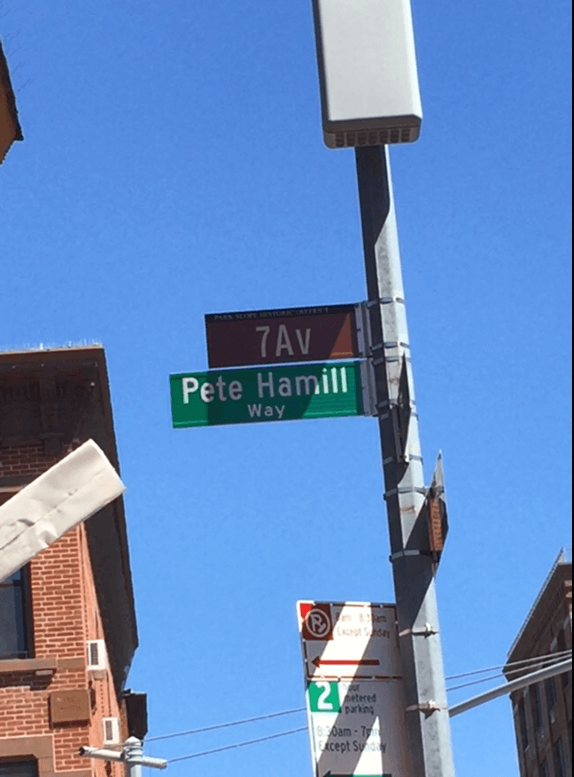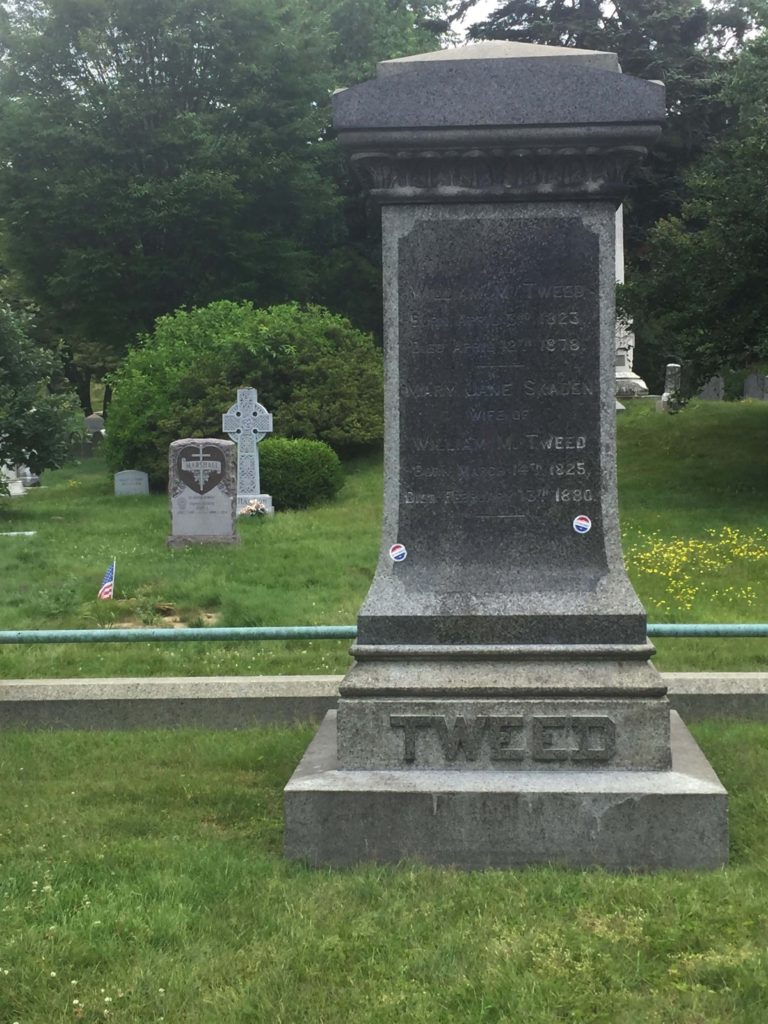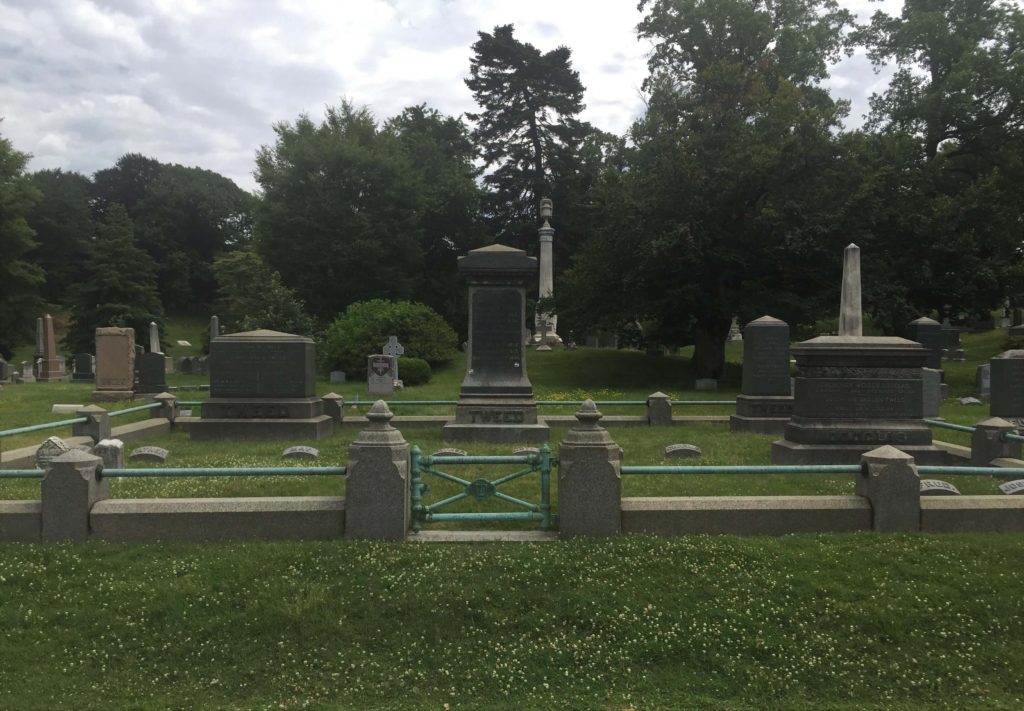“Enright, I need you to cover the Hamill unveiling!”
It was George again. I could almost smell his cheap cigar seeping through my cell phone as I helped a friend scale a striped bass on Canarsie Pier.
“Huh?” I replied in my usual sophisticated way.
“Pete Hamill, you twit! You wrote a memorial to him back in August!”
“Right, I remember, but what, did he die again?”
“Joe, you’re an idiot! They’re dedicating a block to him today. Get on it!”
So there I was at the intersection of 12th Street and 7th Avenue in Park Slope at 2PM on a glorious cloud-free Thursday, June 24h. It would have been Pete’s 86th birthday. I asked around to see if I needed press credentials to take photos, but people edged away from me as if I smelled like fish guts.
Suddenly some guy in a suit blasted out from a microphone that he was a politician. Somebody near me said, “That’s Brad Lander. He’s smiling ‘cause he just won the first round of the primary for Comptroller. I bet he’s thinking about laying his hands on those billions.” Lander observed that Hamill was one of seven Irish mutts born down the block and introduced Pete’s Japanese widow, Fukiko, an esteemed writer herself, who read a sad passage from her husband’s unfinished manuscript about coming home to Brooklyn, Back to the Old Country. She noted that they frequently moved during their 33 years together, which meant packing up 20,000 books over and over again. She recalled how, in their Prospect Heights apartment last August, Pete reached out for her and, as if in slow motion, he toppled away, softly calling, “Fukiko, I’m falling.” Days later he passed away at Methodist Hospital, five blocks from where we all now stood.
Guys behind me started arguing about Pete getting into a fistfight with John Lennon over Fukiko while another politician read from Pete’s A Drinking Life then introduced another politician who read from another Pete essay and, well, pretty soon everybody was reading some of Pete’s great quotes. The top Mayoral primary vote-getter, Brooklyn’s own Eric Adams, talked about Robert F. Kennedy and what a loss the country suffered when he was assassinated, only feet away from his pal, Pete Hamill.
Two of Jimmy Breslin’s kids were there and mention of the 2019 HBO documentary, Breslin and Hamill: Deadline Artists drew warm applause (I loved it, but Pete hated its emphasis on his womanizing 50 years ago). By the way, any mention of the Hamill family’s boundless love for the presently cash-strapped Brooklyn Public Library also got people clapping – politicians, please take note during budget negotiations.
Then Denis Hamill took the mic, thanked everybody for coming and delivered a wonderful heart-felt reminiscence about Pete: the Brooklyn Eagle and Roulston’s delivery boy, high school dropout, Brooklyn Navy Yard machinist, US Navy vet, Mexico art student on the GI Bill, graphic designer, cartoon enthusiast, cub reporter, father, war correspondent, RFK confidant, blue collar journalist, essayist, short-story writer, screenwriter, novelist, editor-in-chief, heavy drinker who throttled back so as not to become an ethnic stereotype…But Denis focused on Pete, as the oldest sibling, turning Brian away from drug-fueled delinquency to become a top-notch photographer and helping Denis, sister Kathleen and brothers John and Joe (both deceased) to become successful writers (brother Tom, apparently the black sheep of the family, became a scientist). Pete did it using heartfelt gentle persuasion, giving generously of his time and wisdom. Denis called it The Pete Hamill Way.
Now Pete is buried in Green-Wood Cemetery, a place he loved, which he always called “the Green-Wood,” as if it were a Bay Ridge bar. As a kid, in the twilight, Pete and his pals would climb the Green-Wood fence at the end of 7th Avenue, eight blocks away from his railroad flat on Pete Hamill Way. Inevitably they would cower in the darkness wondering what specters might emerge beyond the next tombstone. Pete always claimed those imaginings set him on the course to becoming a writer. 70 years later he and Fukiko bought a family plot there after a tour revealed a vacancy near the gaudy gravestone for Boss Tweed. Hamill thought the famously corrupt politician would make for a terrific after-life companion. And good copy. For Pete, it was always about the stories he could tell. Take this one, for example, which he filed with the Daily News on September 11, 2001…
Above us, at 9:55, the first of the towers began to collapse. We heard snapping sounds, pops, little explosions, and then the walls bulged out, and we heard a sound like an avalanche, and here it came. Everything then happened in fragments. I yell to my wife, “Run!” And we start together, and this immense cloud, perhaps 25 stories high, is rolling at us. But bodies come smashing together in the doorway of 25 Vesey St. and I can’t see my wife, and when I push to get out, I’m driven into the lobby. I keep calling her name, and saying, “I’ve got to get out of here, please, my wife.”…[P]olice are caked with white powder, coughing, hacking, spitting, like figures from a horror movie. Then there’s a sound of splintering glass. One of the emergency workers has smashed open the glass doors. I feel as if I’ve been there for an hour; only 14 minutes have passed. “Get going!” a cop yells. “But don’t run!” The street before us is now a pale gray wilderness. There is powdery white dust on gutter and sidewalk, and dust on the roofs of cars, and dust on the tombstones of St. Paul’s. Dust coats all the walking human beings, the police and the civilians, white people and black, men and women. It’s like an assembly of ghosts…To the right, the dust cloud is still rising and falling, undulating in a sinister way, billowing out and then falling in upon itself. The tower is gone. I start running toward Broadway, through dust 2 inches deep. Park Row is white. City Hall Park is white. Sheets of paper are scattered everywhere, orders for stocks, waybills, purchase orders, the pulverized confetti of capitalism. Sirens blare, klaxons wail. I see a black woman with dazed eyes, her hair coated with dust, and an Asian woman masked with powder. I don’t see my wife anywhere. I look into store windows. I peer into an ambulance. I ask a cop if there’s an emergency center. “Yeah,” he says. “Everywhere.”
That was the Pete Hamill Way. Long may your stories be told, Pete.












